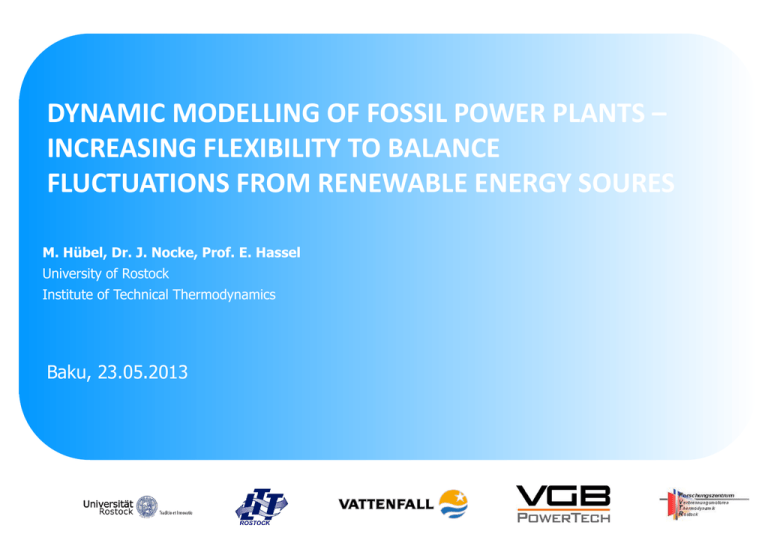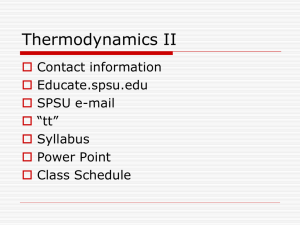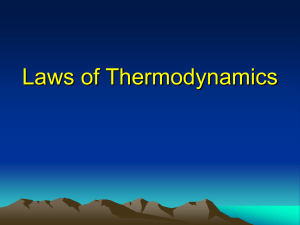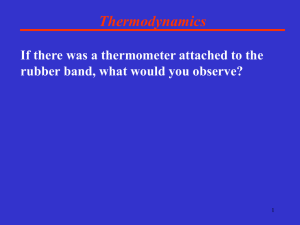Dynamic Modelling of Fossil Power Plants
advertisement

DYNAMIC MODELLING OF FOSSIL POWER PLANTS – INCREASING FLEXIBILITY TO BALANCE FLUCTUATIONS FROM RENEWABLE ENERGY SOURES M. Hübel, Dr. J. Nocke, Prof. E. Hassel University of Rostock Institute of Technical Thermodynamics Baku, 23.05.2013 Overview 1. 2. 3. 4. 5. Motivation Reference PowerPlant Simulation and Validation Example Results Outlook Institute of Technical Thermodynamics – Dynamic Power Plant Simulation 2 Motivation German Electric Energy System 2020 Consumer Load Maximum: ~ 80 GW Average: ~ 60 GW GRID FREQUENCY indicats deviations in the energy balance Installed Capacities Photovoltaic: ~ 50 GW Wind: ~ 55 GW http://meltblog.de/wp-content/uploads/2013/02/Fotolia_45848443_XS.jpg Institute of Technical Thermodynamics – Dynamic Power Plant Simulation 3 Motivation German Electric Energy System 2020 Annual Consumption ~ 600 TWh/a GRID FREQUENCY indicats deviations in the energy balance Annual Production Photovoltaic: ~ 50 TWh Wind: ~ 120 TWh http://meltblog.de/wp-content/uploads/2013/02/Fotolia_45848443_XS.jpg Institute of Technical Thermodynamics – Dynamic Power Plant Simulation 4 Motivation German Electric Energy System 2020 Annual Consumption ~ 600 TWh/a GRID FREQUENCY indicats deviations in the energy balance Annual Production Photovoltaic: ~ 50 TWh Wind: ~ 120 TWh http://meltblog.de/wp-content/uploads/2013/02/Fotolia_45848443_XS.jpg Institute of Technical Thermodynamics – Dynamic Power Plant Simulation 5 Motivation Role of Fossil Power Plants in the German Electric Energy System • Most of our consumed electric energy is from thermal power plants – today and in the next decades • Some grid services, e.g. Primary Control can currently be done only by thermal power plants • (too) little investments for modernization and optimization within this sector – high potential for optimization P Gradmax Pmin t Decreasing Minimum Load Increasing Load Gradients GOAL: Flexible power plants Operating Schedule Institute of Technical Thermodynamics – Dynamic Power Plant Simulation METHODE: Dynamic Modeling • Identify restrictions • Develop optimization strategies • Comparison of scenarios 6 Reference Power Plant Jänschwalde Block D • • • • • Year of commissioning: combustible: generator output: Efficiency: live steam 1985 lignite 530 MW 36% mass flow rate: pressure: 2x230 kg/s 162 bar temperature: 535 °C Lehrstuhl für Technische Thermodynamik – Dynamische Modellierung des Kraftwerks “Jänschwalde” 7 Overview on Power Plant / Model Structure Boiler Turbine Condensator LP-Preheaters Feedwater System HP-Preheaters Lehrstuhl für Technische Thermodynamik – Dynamische Modellierung des Kraftwerks “Jänschwalde” 8 Fundamental equations Outlet Outlet massflow enthalpy flux Mass balance Outlet p n dm m i dt i 1 Energy balance n dU hi m i Q Wt dt i 1 Toutside Tinside Momentum balance n n n d (m c) Ai i ci (ci ni ) A0 p f Ai i ni Ai i gzi ni dt i 1 i 1 i 1 Δp TFluid Heat transfer dT d 2T a 2 dt dr Q AT Inside wall at boundary layer according Fouriers heat transfer equation α determined by Dittus-Boelter (1-phase flow) or Chen-correlation (2-phase flow) heat flux Inlet p Inlet massflow Inlet enthalpy flux Simulation and Validation Input Data Results Institute of Technical Thermodynamics – Transient Modeling of the Lignite Power Plant “Jänschwalde” 10 Simulation and Validation Power Output P Generator P Generator Simulated Institute of Technical Thermodynamics – Transient Modeling of the Lignite Power Plant “Jänschwalde” 11 Simulation and Validation Boiler Temperatures Institute of Technical Thermodynamics – Transient Modeling of the Lignite Power Plant “Jänschwalde” 12 Simulation and Validation Preheater Temperatures Institute of Technical Thermodynamics – Transient Modeling of the Lignite Power Plant “Jänschwalde” 13 Simulation and Validation Preheater Temperatures Institute of Technical Thermodynamics – Transient Modeling of the Lignite Power Plant “Jänschwalde” 14 Example Results Fatigue in components for the reference scenario Result • Fartigue for the components varies between 0,0008 and 0,0051 % for the reference scenario • Evaporator and Superheater 2 are critical components in dynamic operation Conclusion • Fartigue of Headers Same input scenario dones not lead to same fatigue because of different temperatues and different geometries Outlook Lastgradient Load gradient Scenarios 2.5%, 4%, 6% Gradmax Pmin operation parameters Mindestlast Min load scenarios 50%, 37.5%, 33%, 20 % different operation modes Simulation of critical load and wind scenarios under variation of load gradient, min load of PP Jänschwalde or operation of the power plant in special mode special operation modes „shut down & restart“ „reduce to circulation mode“ Institute of Technical Thermodynamics – Effects of fluctuating Wind Power on Power plant operation Stillstand 16 Thank you for your attention! Dipl.-Ing. M. Hübel Dr.-Ing. J. Nocke Prof. Dr.-Ing. E. Hassel And thanks to our sponsors for financial support Institute of Technical Thermodynamics – Dynamic Power Plant Simulation 17











